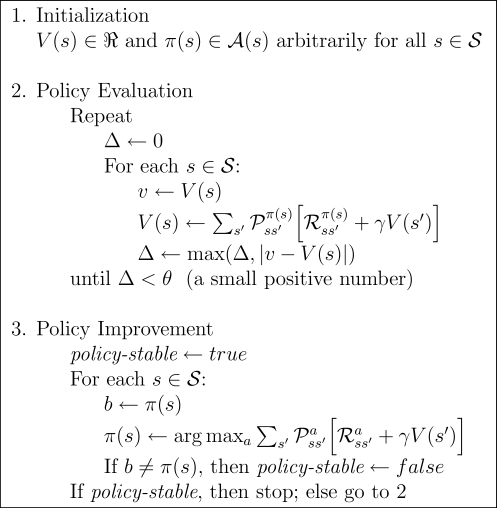昨天提到策略增進,是一個使用計算出的狀態價值,去選擇在每個狀態下,最好的動作的方法。其中,我們在選擇動作時,使用動作價值函數計算動作價值,並使用動作價值最高的動作,作為這個狀態下最好的動作。
透過狀態價值,我們找到每個狀態下最好的動作。那麼,用這個動作再回去計算狀態價值,我們就可以得到更準確的狀態價值。重複這個過程的話,最終我們可以逼近各狀態的價值 ( ),與各狀態下最適合的動作 (
),與各狀態下最適合的動作 ( )。
)。
 (取自 Sutton 書籍)
(取自 Sutton 書籍)
上圖中重複的過程,就是我們上述「計算狀態價值」與「各狀態最適動作」。以下是這個方法的演算法:

以下一邊介紹演算法的內容,一邊說明相關的程式碼。
## environment setting
# action
BestAction = np.random.randint(0,4,16)
ProbAction = np.zeros([16,4])
ProbAction[1:15,:] = 0.25
# value function
FuncValue = np.zeros(16)
# reward function
FuncReward = np.full(16,-1)
FuncReward[0] = 0
FuncReward[15] = 0
# transition matrix
T = np.load('./gridworld/T.npy')
gamma = 0.99
theta = 0.05
counter_total = 0
PolicyStable = False
def PolicyEvalution(func_value, best_action, func_reward, trans_mat, gamma):
func_value_now = func_value.copy()
for state in range(1,15):
next_state = trans_mat[:, state, best_action[state]]
future_reward = func_reward + func_value_now*gamma
func_value[state] = np.sum(next_state*future_reward)
delta = np.max(np.abs(func_value - func_value_now))
return func_value, delta
def PolicyImprovement(func_value, best_action, prob_action, func_reward, trans_mat, gamma):
policy_stable = False
best_action_now = best_action.copy()
for state in range(1,15):
prob_next_state = prob_action[state]*trans_mat[:,state,:]
future_reward = func_reward + func_value*gamma
best_action[state] = np.argmax(np.matmul(np.transpose(prob_next_state), future_reward))
if np.all(best_action == best_action_now):
policy_stable = True
return best_action, policy_stable
def main():
## environment setting
# action
BestAction = np.random.randint(0,4,16)
ProbAction = np.zeros([16,4])
ProbAction[1:15,:] = 0.25
# value function
FuncValue = np.zeros(16)
# reward function
FuncReward = np.full(16,-1)
FuncReward[0] = 0
FuncReward[15] = 0
# transition matrix
T = np.load('./gridworld/T.npy')
# parameters
gamma = 0.99
theta = 0.05
counter_total = 0
PolicyStable = False
# iteration
while not PolicyStable:
delta = theta + 0.001
counter = 1
counter_total += 1
while delta > theta:
FuncValue, delta = PolicyEvalution(FuncValue, BestAction, FuncReward, T, gamma)
counter += 1
os.system('cls' if os.name == 'nt' else 'clear')
ShowValue(delta, theta, gamma, counter_total, counter, FuncValue)
time.sleep(2)
BestAction, PolicyStable = PolicyImprovement(FuncValue, BestAction, ProbAction, FuncReward, T, gamma)
PolicyString = ShowPolicy(counter_total, BestAction)
time.sleep(2)
os.system('cls' if os.name == 'nt' else 'clear')
print('='*60)
print('Final Result')
print('='*60)
print('[State-value]')
print(FuncValue.reshape(4,4))
print('='*60)
print('[Policy]')
print(PolicyString.reshape(4,4))
print('='*60)
這個部分的內容包含 Step 1 中設定的參數,並設定迴圈的中止條件。經過四次「計算狀態價值」與「選擇最佳動作」的過程,我們得到結果如下: ('*'為終點,尖端為最佳移動方向)
============================================================
Final Result
============================================================
[State-value]
[[ 0. 0. -1. -1.99]
[ 0. -1. -1.99 -1. ]
[-1. -1.99 -1. 0. ]
[-1.99 -1. 0. 0. ]]
============================================================
[Policy]
[['*' '<' '<' '<']
['^' '^' '^' 'v']
['^' '^' 'v' 'v']
['^' '>' '>' '*']]
============================================================
以上,我們完成使用 Policy Iteration 進行決策,完整程式碼請見 GitHub。
